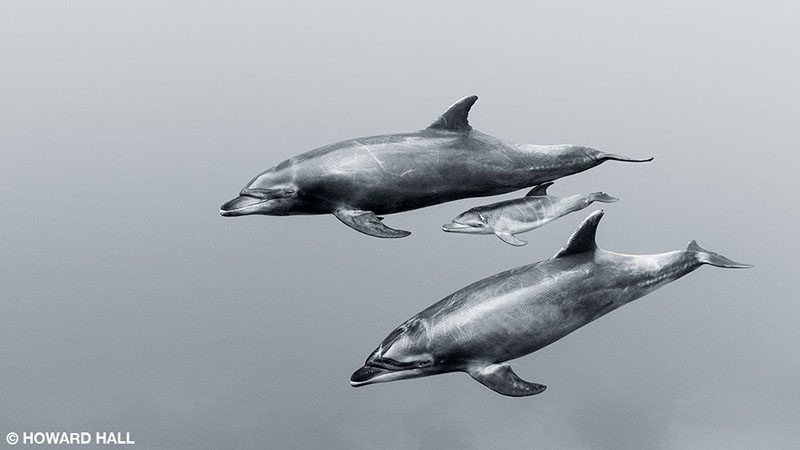From the moment we back-rolled off the inflatable panga, great things were happening. To our left, a pair of giant mantas gracefully winged their way toward us, while a 20-foot whale shark approached from the right. Soon I would have to choose which of these compelling subjects to photograph first, but I still had to descend, adjust buoyancy, position strobes and do all the preliminary tasks required at the beginning of any dive. As I was preparing, my buddy, Jean Marie, started tapping me on the shoulder, pointing emphatically into the blue and all but shouting through his regulator.
We were at a dive site called the Boiler, a submerged pinnacle just off San Benedicto Island, which is part of Mexico’s Revillagigedo Archipelago. Best known for its abundance of mantas, sharks and other big marine life, the archipelago has been a United Nations Educational, Scientific and Cultural Organization (UNESCO) World Heritage Site since 2016. It is the kind of place where just about anything can show up. Judging by the huge creatures now approaching us, it’s easy to understand how this area earned its reputation for big-animal excitement. Little did we know that we would soon witness something exceptional even for this location.
As I looked in the direction of Jean Marie’s wild gesturing, a bottlenose dolphin appeared a few feet in front of us, eyeing our little group as she paused her swimming. As I was scrambling to prepare my camera, I noticed something extraordinary — protruding from the dolphin’s swollen belly was a perfectly shaped set of tail flukes. As the pregnant dolphin made several close passes, it became clear that she was in the midst of giving birth, which I later learned has never been observed in the wild. Watching her swim away, I thought this encounter seemed too incredible to be true. Had we really just seen that?
She soon reappeared, but this time she kept her distance until our divemaster, Jessie, started twirling in the water. The dolphin almost immediately approached us again, providing another round of close interaction and amazing photo opportunities. While I still hadn’t adjusted my camera settings, I managed to at least remove the lens cover and snap a few grab shots.
Childbirth typically does not involve much curiosity or playfulness on the part of the mother, at least while in the midst of labor. Imagine our amazement when this sensitive, highly intelligent animal made several more appearances and circled us at close range, obviously intrigued by our presence.
The mother dolphin returned again toward the end of our dive, but the birth hadn’t progressed much; only about a third of the calf’s body was protruding. She made a few more casual passes while another dolphin lingered in the distance, and then the pair eventually headed off into the blue.
After the dive we discussed with others on our liveaboard the typical length of the birthing process and speculated that perhaps the birth wasn’t successful. At this point we could only guess and hope for the best.
We were on a weeklong expedition as guests of Blancpain, a pioneer among dive watch manufacturers and founding sponsors of National Geographic’s Pristine Seas campaign and other marine conservation projects. Among their latest accomplishments is an extensive scientific survey of the Revillagigedos, considered instrumental in Mexico’s recent declaration of this region as North America’s largest marine protected area. For us, being surrounded by robust fish populations and a constant parade of big animals on nearly every dive, the value of such protections was obvious. We considered ourselves fortunate to experience such an abundance of ocean life, but we continued to wonder about the fate of the baby dolphin.
We returned to the Boiler a few days later for another visit with the site’s famously friendly mantas. The mantas put on a captivating show, but the real highlight was an encounter with a mother dolphin and her very young calf, which was witnessed by several expedition members, including marine scientist and photographer Laurent Ballesta. None of them had seen the pregnant dolphin on our first visit, so we speculated if this was the same mother and calf. Both Laurent and I had taken photos of the dolphin, so we compared images to settle the matter. As we viewed photos from each encounter, identical scars on the mother confirmed what we had suspected: The birth had indeed been successful, as evidenced by the healthy calf closely accompanying its mom.

A few weeks later, natural history filmmakers Howard and Michele Hall were diving with mantas at the Boiler, where they too encountered a mother dolphin with a young calf. Howard’s images show matching scars that confirm this dolphin was the same mother we had initially encountered. Young dolphins typically stay with their mothers for three to six years, and the dolphins of San Benedicto seem quite territorial, so anyone diving there in the next few years may also have a chance to encounter these same animals.
While reflecting on this special experience, I thought about the importance of protecting unique, exceptionally healthy places like Mexico’s Revillagigedo Archipelago. As our water planet continues to face serious challenges such as climate change, pollution and overfishing, protected areas can serve as new epicenters of marine productivity, prompting the recovery of marine life in the reserves and surrounding areas. If such programs are managed responsibly and implemented in enough of the right places, they could play a major role in improving the state of our oceans. Let’s hope all the organizations and individuals who advocate tirelessly for these programs can keep up their good work.